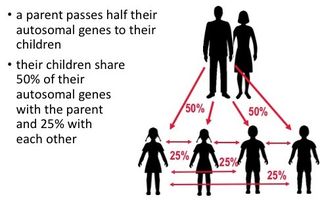Marriage
The Genetic Case for Monogamy
Lifelong monogamy may avoid the worst effects of genetic conflict.
Posted February 6, 2019
In a previous post, I outlined the imprinted brain theory in a thousand words. One important implication of it is that the theory suggests that life-long monogamy between two biological parents is best, both for them, and for their children.
The reason is simple: Monogamy increases the likelihood that all the children of the mother will share the same father. If they do, siblings are all equally related by half their genes, both to each other, and to each parent. But if children of the same mother have different fathers, their paternal genetic relatedness is zero, so they are only half-siblings, related to each other by a quarter of their genes: those they got from their mother.

According to the conflict theory of genomic imprinting on which the imprinted brain theory is based, imprinting evolved because of the huge asymmetry between the parental investment of the mother—everything at birth, and more afterwards via her lactation and likely prominent role in child-rearing. The father’s contribution is the genes of a single sperm: in the objective, quantitative terms of addition to birth-weight, billions of times less!
It follows that maternal parental investment in a child is in effect a free lunch for the father’s genes present in the child (and, before birth, in its placenta). Consequently, these genes seek to maximize growth, for example by driving up maternal blood pressure and sugar during gestation, risking gestational hypertension and diabetes for the mother—both disorders caused by paternally-active imprinted genes in the foetus/placenta.
After birth, the imprinted brain theory proposes that these conflicts continue, with paternal genes pushing in an autistic direction, and maternal ones pushing towards the psychotic end of the spectrum. If both sides are evenly matched, the result is normality; but an unbalanced outcome results either in an autistic or psychotic spectrum disorder.
If children are related through the father and if he is likely to have no other mate, he has a genetic self-interest much more like that of the mother. Perhaps this is why there is evidence that the presence of the father during the pregnancy of his child lowers maternal blood pressure.
Shared genes encourage co-operation according to a well-attested formula, and so siblings of the same parents can be predicted to be about twice as co-operative or half as selfish towards each other than might half-siblings.
But if this is so, how would siblings know that they were related? There is plenty of evidence which argues that personal scent is the key. Studies show that although children aged 5 to 8 recognize the mother's scent only if they are breast-fed sons, all children recognize the father. And if that is the case, then it is not far-fetched to suppose that they might also be able to detect shared paternity in each other in the same way.
The so-called rhinencephalon, or “smell-brain” is one of the oldest and most fundamental parts of the brain and sends its information directly to the limbic system which controls gut feelings, emotional responses, aggression, desire, and appetite. The father’s genes are preferentially expressed here, underlining the importance of paternity to it. So, the likelihood is that children can subliminally detect shared paternity by means of smell via brain systems predominantly built by the father’s genes.
The mother’s genes, by contrast, are preferentially expressed in higher cortical centers involved in inhibition, cognition, and social skills; and this fits the finding that the mother is likely to be the chief agent of early socialization.
In the past, evidence linking the presence of a father within the family to better outcomes for children—or at least, less bad ones—was interpreted in Freudian terms, despite the fact that the evidence pointed towards the father encouraging more independent and self-assertive behavior. Nevertheless, these findings fit the imprinted brain theory if we substitute genetic for psychological influence and suggest that, as many believe, the presence of the father is a key factor in childhood development.
At the very least, the imprinted brain theory implies that reduced genetic conflict predicts lessened psychological and social conflict all round, however it may come about. Therefore, maximizing the relatedness of members of the nuclear family to one another is an obvious recommendation, however much it may go against currently fashionable social ideology.
References
Porter, R. H. and J. Winberg (1999). Unique salience of maternal breast odors for newborn infants. Neuroscience and Biobehavioral Reviews 23(3): 439-449.
Haig, D. (1993). "Genetic conflicts in human pregnancy." Quarterly Review Of Biology 68(4): 495-532.
Lamb, M., Ed. (1981). The Role of the Father in Child Development. New York, Wiley.


